Sustainable energy: Difference between revisions
Nuclear power |
Theanphibian (talk | contribs) →Nuclear power: removing vast quantities of blatant rants, Wikipedia is not your blog |
||
| Line 87: | Line 87: | ||
==Nuclear power== |
==Nuclear power== |
||
It is said that nuclear has the potential to be sustainable, however, this is often qualified with the argument that there are serious challenges that must be dealt with before it drastically increases it's role.<ref>World Nuclear Association. [http://www.world-nuclear.org/sym/1997/bourd.htm Nuclear Power |
|||
and Sustainable Development].</ref> |
|||
| ⚫ | Fission power's long-term sustainability depends on the amount of uranium and thorium that are available to be mined. Estimates for fuel reserves vary widely, but if [[breeder reactor]]s and fuel reprocessing are assumed, estimates tend to be tens of thousands of years or longer{{fact}} (uranium is approximately as common in Earth's crust as [[tin]] or [[zinc]] (2 ppm), and thorium as common as [[lead]] (6 ppm)).{{fact}} |
||
Sustainable energy sources that aren't renewable are those whose stock is not replenished, but for which the presently available stocks are expected to last for as long as human civilization wants to use them. However, as of 2008, nuclear technology is not able to provide indefinite energy. |
|||
Some of these energy sources are derived from [[nuclear energy]], as many other forms of [[potential energy|stored energy]] found on Earth do not have sufficient energy capacity to supply humanity indefinitely. There are exceptions however, such as the very large [[thermal mass]] of earth's [[geothermal]] energy, as well as the enormous [[tidal energy]] between the earth and the moon. The sun also has a very large energy capacity which is automatically delivered to earth every day. |
|||
| ⚫ | Fusion power's long-term sustainability depends on the amount of [[lithium]] that is available to be mined (for deuterium-tritium fusion), or the amount of [[deuterium]], a hydrogen isotope, available in "[[heavy water]]" (for deuterium-deuterium fusion). Lithium is a reasonably common component of Earth's crust, being about 10 times as common as thorium (65 ppm). Deuterium occurs in small concentrations wherever hydrogen is found (principally in water), at about 150 ppm. As it can be extracted easily from seawater. Economically viable reserves of deuterium are for practical purposes unlimited.{{fact}} |
||
* [[nuclear power|Fission power]] is the only technology that has every been used in [[power plant]]s. It uses the [[nuclear fission]] of heavy elements to release energy that drives a [[heat engine]]. Some of the primary challenges with the use of fission power, are the production of small quantities of highly-radioactive waste in the form of spent fuel, larger quantities of less-radioactive waste in the form of [[neutron activation|activated]] structural material. Further challenges, for use as a long-term power source, are the need to perform intensive processing of highly-radioactive fuel bundles. This is required both to reclaim unused fuel in spent fuel rods, and to reclaim [[plutonium]] 239 and [[uranium]] 233 that have been bred from uranium 238 and [[thorium]] 232, respectively. |
|||
* [[Fusion power]] has never been used successfully for power production, other than in [[thermonuclear weapon]]s. It uses the [[nuclear fusion]] of isotopes of [[hydrogen]] to release energy that drives a heat engine. Primary challenges with the use of fusion power are that the technology required to build a useful fusion power plant are still under development. Also, radioactive waste is created in the form of [[neutron activation|activated]] structural material. |
|||
| ⚫ | Fission power's long-term sustainability depends on the amount of uranium and thorium that are available to be mined. Estimates for fuel reserves vary widely, but if [[breeder reactor]]s and fuel reprocessing are assumed, estimates tend to be tens of thousands of years or longer{{fact}} (uranium is approximately as common in Earth's crust as [[tin]] or [[zinc]] (2 ppm), and thorium as common as [[lead]] (6 ppm)). |
||
| ⚫ | Fusion power's long-term sustainability depends on the amount of [[lithium]] that is available to be mined (for deuterium-tritium fusion), or the amount of [[deuterium]], a hydrogen isotope, available in "[[heavy water]]" (for deuterium-deuterium fusion). Lithium is a reasonably common component of Earth's crust, being about 10 times as common as thorium (65 ppm). Deuterium occurs in small concentrations wherever hydrogen is found (principally in water), at about 150 ppm. As it can be extracted easily from seawater. Economically viable reserves of deuterium are for practical purposes unlimited. |
||
Fusion has yet to be made economical. |
|||
===Technical sustainability of nuclear power=== |
===Technical sustainability of nuclear power=== |
||
Discussions are re-emerging on the controversial subject of classifying nuclear energy under such umbrella terms as "renewable" and "sustainable". These attributes bring moral gains or eligibility for development aid under various jurisdictions.{{fact}} |
|||
The primary argument in favor of "renewable" status is the relatively inexhaustible supply of fuel available ([[uranium]] and [[thorium]] for [[nuclear fission|fission]] or [[hydrogen]] for [[nuclear fusion|fusion]]). See also: [[Renewable energy#Nuclear power|Renewable energy, ''Nuclear power'' section]]. |
|||
The arguments opposing "renewable" status concern the production of nuclear waste having a [[half life]] of many hundreds of years, the risk to public safety, and the increased costs paid for by taxpayers which are required to make plants safer for operation, more safe from terrorist attacks, and to safely dispose of nuclear waste so that it is non-polluting. |
|||
| ⚫ | Proponents, such as environmentalists [[James Lovelock]], [[Patrick Moore (environmentalist)|Patrick Moore]] ([[Greenpeace]] co-founder), [[Stewart Brand]] (creator of The [[Whole Earth Catalog]]), and [[Norris McDonald]] (president of the [[African American Environmentalist Association|AAEA]]), also claim that nuclear power is at least as environmentally friendly as traditional sources of renewable energy, making it part of the solution to [[global warming]] and the world's growing need for energy. They note that nuclear power plants produce little carbon dioxide emissions and point out that the radioactive waste produced is minimal and well-contained, especially compared to fossil fuels. <ref>[http://www.nei.org/index.asp?catnum=2&catid=322 Prominent Environmentalists Support Nuclear Energy]</ref> |
||
Other energy experts and environmentalists maintain that there are vast quantities of renewable energy available. So while there is a strong demand for energy, nuclear energy is not the only option, so there is not a strong ''need'' for nuclear energy per se. The ''need'' for renewables is at least as strong, if not stronger. These abundant renewable sources include: [[hydropower]], [[biomass]], [[wind]], [[solar]], [[wave energy]], [[tidal energy]], and [[geothermal energy]]. These seven technologies are well developed and working power plants exist to prove their viability (unlike fusion), and none of these produce toxic waste (unlike fission). These renewable power plants are not high risk targets for terrorist attacks. For example, armed guards are not needed to protect a wind turbine. Also they do not consume fuel, whereas nuclear energy does, so energy is not consumed (and carbon dioxide is not released) in the process of mining fuel, nor in the transporting of fuel and waste materials. Renewable energy is natural, not artificial, so it is an inherently more [[environmentally friendly]] source of energy. If heat from nuclear fission is desired, then it can be obtained from geothermal energy with far lower risk to public safety and the environment, and no waste disposal issues. |
|||
{{seealso|Environmental effects of nuclear power}} |
|||
===Controversy=== |
|||
The use of nuclear power requires storage of [[radioactive waste]] for long periods, there is controversy regarding the risk for [[radioactive contamination]] by accident or sabotage , and the possibility that its use could in some countries lead to the [[nuclear proliferation|proliferation]] of [[nuclear weapons]]. |
|||
Serious nuclear accidents have occurred in the past. These include the 1986 [[Chernobyl disaster]], the 1979 [[Three Mile Island accident]], the 1957 [[Windscale fire]], and the 1957 [[Mayak]] accident. The nuclear power industry went into a period of decline for some years following the Chernobyl and Three Mile Island accidents. |
|||
Some critics of nuclear energy argue that deployment of nuclear reactors in many countries would accelerate the proliferation of [[nuclear weapon]]s technology that has many links with civilian use of nuclear materials. Some designs of nuclear reactors can be readily used to breed high grade Plutonium-239, which can be used to produce nuclear weapons. |
|||
The issue of fuel reprocessing and/or long-term repository of [[nuclear waste]] materials also remains contentious. Only a few countries have developed waste depositories for high-level [[radioactivity|radioactive]] waste (see: [[Yucca Mountain|Yucca Mountain Repository]] [[USA]]; [[Gorleben]] [[Germany]]; [[Forsmark Nuclear Power Plant#Waste disposal|Forsmark]], [[Sweden]]). |
|||
| ⚫ | Proponents, such as environmentalists [[James Lovelock]], [[Patrick Moore (environmentalist)|Patrick Moore]] ([[Greenpeace]] co-founder), [[Stewart Brand]] (creator of The [[Whole Earth Catalog]]), and [[Norris McDonald]] (president of the [[African American Environmentalist Association|AAEA]]), also claim that nuclear power is at least as environmentally friendly as traditional sources of renewable energy, making it part of the solution to [[global warming]] and the world's growing need for energy. They note that nuclear power plants produce little carbon dioxide emissions and point out that the radioactive waste produced is minimal and well-contained, especially compared to fossil fuels. <ref>Nuclear Energy Institute. [http://web.archive.org/web/20060425113422/http://www.nei.org/index.asp?catnum=2&catid=322 Prominent Environmentalists Support Nuclear Energy]</ref> |
||
Due to opposition to nuclear power, some countries ([[Austria]], [[Italy]], Sweden, Germany) have effectively banned further development of nuclear energy{{Fact|date=September 2007}}, though debate regarding future uses of nuclear energy is ongoing in Sweden and Germany {{Fact|date=September 2007}}. Some other countries, such as Australia, have never built a nuclear power station. |
|||
== See also == |
== See also == |
||
Revision as of 00:15, 20 February 2008
Sustainable energy sources are energy sources which are not expected to be depleted in a timeframe relevant to the human race, and which therefore contribute to the sustainability of all species.
Sustainable energy sources are most often regarded as including all renewable sources, such as solar power, wind power, wave power, geothermal power, tidal power and others.
Discounting the small risk of large-scale nuclear accidents, terrorism and other major disasters, nuclear power and nuclear fusion meet this definition of sustainability, but there is controversy over whether or not they should be regarded as sustainable for social and political reasons.
Distinction from other terms
Some ways in which sustainable energy has been defined are:
- Effectively, the provision of energy such that it meets the needs of the future without compromising the ability of future generations to meet their own needs. Sustainable Energy has two key components; renewable energy and energy efficiency.[1] - Renewable Energy and Efficiency Partnership (British)
- Energy which is replenishable within a human lifetime and causes no long-term damage to the environment.[2] - Jamaica Sustainable Development Network
This sets apart sustainable energy from other renewable energy terminology such as Alternative energy and Green energy by focusing on the ability of an energy source to continue providing energy. Requirements such as non-polluting may be relaxed for the definition of sustainable energy, provided that such negative effects do not prohibit heavy use of the source for an indefinite amount of time.
Renewable energy technologies
| Part of a series on |
| Renewable energy |
|---|
 |
Renewable energy technologies are essential contributors to sustainable energy as they generally contribute to world energy security, reducing dependency on fossil fuel resources, and providing opportunities for mitigating greenhouse gases.[3] The International Energy Agency has defined three generations of renewable energy technologies, reaching back more than 100 years:[3]
- First-generation technologies emerged from the industrial revolution at the end of the 19th century and include hydropower, biomass combustion, and geothermal power and heat. Some of these technologies are still in widespread use.
- Second-generation technologies include solar heating and cooling, wind power, modern forms of bioenergy, and solar photovoltaics. These are now entering markets as a result of research, development and demonstration (RD&D) investments since the 1980s. The initial investment was prompted by energy security concerns linked to the oil crises of the 1970s but the continuing appeal of these renewables is due, at least in part, to environmental benefits. Many of the technologies reflect significant advancements in materials.
- Third-generation technologies are still under development and include advanced biomass gasification, biorefinery technologies, concentrating solar thermal power, hot-dry-rock geothermal power, and ocean energy. Advances in nanotechnology may also play a major role.[3]
First- and second-generation technologies have entered the markets, and third-generation technologies heavily depend on long term RD&D commitments, where the public sector has a role to play.[3]
First-generation technologies

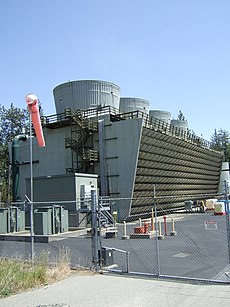
First-generation technologies are most competitive in locations with abundant resources. Their future use depends on the exploration of the available resource potential, particularly in developing countries, and on overcoming challenges related to the environment and social acceptance. Among sources of renewable energy, hydroelectric plants have the advantages of being long-lived -- many existing plants have operated for more than 100 years. Also, hydroelectric plants are clean and have few emissions. Criticisms directed at large-scale hydroelectric plants include: dislocation of people living where the reservoirs are planned, and release of significant amounts of carbon dioxide during construction and flooding of the reservoir.[4] However, it has been found that high emissions are associated only with shallow reservoirs in warm (tropical) locales. Generally speaking, hydroelectric plants produce much lower life-cycle emissions than other types of generation. Hydroelectric power, which underwent extensive development during growth of electrification in the 19th and 20th centuries, is experiencing resurgence of development in the 21st century. The areas of greatest hydroelectric growth are the booming economies of Asia. China is the development leader; however, other Asian nations are installing hydropower at a rapid pace. This growth is driven by much increased energy costs -- especially for imported energy -- and widespread desires for more domestically-produced, clean, renewable, and economical generation.
Geothermal power plants can operate 24 hours per day, providing base-load capacity, and the world potential capacity for geothermal power generation is estimated at 85 GW over the next 30 years. However, geothermal power is accessible only in limited areas of the world, including the United States, Central America, Indonesia, East Africa and the Philippines. The costs of geothermal energy have dropped substantially from the systems built in the 1970s.[3] Geothermal heat generation can be competitive in many countries producing geothermal power, or in other regions where the resource is of a lower temperature.
Second-generation technologies
Markets for second-generation technologies are strong and growing, mainly in countries such as Germany, Spain, the United States, and Japan. The challenge is to broaden the market base for continued growth worldwide. Strategic deployment in one country not only reduces technology costs for users there, but also for those in other countries, contributing to overall cost reductions and performance improvement.[3]
Solar heating systems are a well known second-generation technology and generally consist of solar thermal collectors, a fluid system to move the heat from the collector to its point of usage, and a reservoir or tank for heat storage and subsequent use. The systems may be used to heat domestic hot water, swimming pool water, or for space heating.[5] The heat can also be used for industrial applications or as an energy input for other uses such as cooling equipment.[6] In many climates, a solar heating system can provide a very high percentage (50 to 75%) of domestic hot water energy.
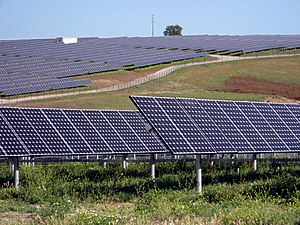
In the 1980s and early 1990s, most photovoltaic modules provided Remote Area Power Supply, but from around 1995, industry efforts have focused increasingly on developing building integrated photovoltaics and power plants for grid connected applications (see photovoltaic power stations article for details). Currently the largest photovoltaic power plant in North America is the Nellis Solar Power Plant (15 MW).[7][8] There is a proposal to build a Solar power station in Victoria, Australia, which would be the world's largest PV power station, at 154 MW.[9] [10] Other large photovoltaic power stations, which have been proposed or are under construction, include the Girrasol solar power plant (62 MW),[11] and the Waldpolenz Solar Park (40 MW).[12]
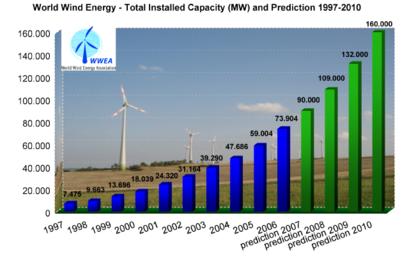
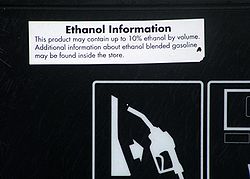
Some of the second-generation renewables, such as wind power, have high potential and have already realised relatively low production costs. At the end of 2006, worldwide capacity of wind-powered generators was 74,223 megawatts, and although it currently produces less than 1% of world-wide electricity use, it accounts for approximately 20% of electricity use in Denmark, 9% in Spain, and 7% in Germany.[13][14] However, it may be difficult to site wind turbines in some areas for aesthetic or environmental reasons, and it may be difficult to integrate wind power into electricity grids in some cases.[3]
Brazil has one of the largest renewable energy programs in the world, involving production of ethanol fuel from sugar cane, and ethanol now provides 18 percent of the country's automotive fuel. As a result of this, together with the exploitation of domestic deep water oil sources, Brazil, which years ago had to import a large share of the petroleum needed for domestic consumption, recently reached complete self-sufficiency in oil.[15][16][17]
Most cars on the road today in the U.S. can run on blends of up to 10% ethanol, and motor vehicle manufacturers already produce vehicles designed to run on much higher ethanol blends. Ford, DaimlerChrysler, and GM are among the automobile companies that sell “flexible-fuel” cars, trucks, and minivans that can use gasoline and ethanol blends ranging from pure gasoline up to 85% ethanol (E85). By mid-2006, there were approximately six million E85-compatible vehicles on U.S. roads.[18]
Third-generation technologies
Third-generation technologies are still under development and include advanced biomass gasification, biorefinery technologies, solar thermal power stations, hot-dry-rock geothermal power, and ocean energy.[3] Third-generation technologies are not yet widely demonstrated or have limited commercialization. Many are on the horizon and may have potential comparable to other renewable energy technologies, but still depend on attracting sufficient attention and RD&D funding.[3]
According to the International Energy Agency, new bioenergy (biofuel) technologies being developed today, notably cellulosic ethanol biorefineries, could allow biofuels to play a much bigger role in the future than previously thought.[19] Cellulosic ethanol can be made from plant matter composed primarily of inedible cellulose fibers that form the stems and branches of most plants. Crop residues (such as corn stalks, wheat straw and rice straw), wood waste, and municipal solid waste are potential sources of cellulosic biomass. Dedicated energy crops, such as switchgrass, are also promising cellulose sources that can be sustainably produced in many regions of the United States.[20]
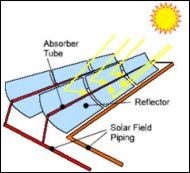
Solar thermal power stations have been successfully operating in California commercially since the late 1980s, including the largest solar power plant of any kind, the 350 MW Solar Energy Generating Systems. Nevada Solar One is another 64MW plant which has recently opened.[21] Other parabolic trough power plants being proposed are two 50MW plants in Spain, and a 100MW plant in Israel.[22]
In terms of Ocean energy, another third-generation technology, Portugal has the world's first commercial wave farm, the Aguçadora Wave Park, under construction in 2007. The farm will initially use three Pelmis P-750 machines generating 2.25 MW.[23] [24] and costs are put at 8.5 million euro. Subject to successful operation, a further 70 million euro is likely to be invested before 2009 on a further 28 machines to generate 525 MW.[25] Funding for a wave farm in Scotland was announced in February, 2007 by the Scottish Executive, at a cost of over 4 million pounds, as part of a £13 million funding packages for ocean power in Scotland. The farm will be the world's largest with a capacity of 3 MW generated by four Pelamis machines.[26] (see also Wave farm).
In 2007, the world's first commercial tidal power station is to be installed in the narrows of Strangford Lough in Ireland. The 1.2 megawatt underwater tidal electricity generator, part of Northern Ireland's Environment & Renewable Energy Fund scheme, will take advantage of the fast tidal flow (up to 4 metres per second) in the lough. Although the generator is expected to be powerful enough to power a thousand homes, the turbine will have minimal environmental impact, as it will be almost entirely submerged, and the rotors pose no danger to wildlife as they turn quite slowly.[27]
Solar power panels that use nanotechnology, which can create circuits out of individual silicon molecules, may cost half as much as traditional photovoltaic cells, according to executives and investors involved in developing the products. Nanosolar has secured more than $100 million from investors to build a factory for nanotechnology thin-film solar panels. The company expects the factory to open in 2010 and produce enough solar cells each year to generate 430 megawatts of power.[28]
Sustainable energy
Moving towards energy sustainability will require changes not only in the way energy is supplied, but in the way it is used, and reducing the amount of energy required to deliver various goods or services is essential. Opportunities for improvement on the demand side of the energy equation are as rich and diverse as those on the supply side, and often offer significant economic benefits.[29]
Renewable energy and energy efficiency are sometimes said to be the “twin pillars” of sustainable energy policy. Both resources must be developed in order to stabilize and reduce carbon dioxide emissions. Efficiency slows down energy demand growth so that rising clean energy supplies can make deep cuts in fossil fuel use. If energy use grows too fast, renewable energy development will chase a receding target. Likewise, unless clean energy supplies come online rapidly, slowing demand growth will only begin to reduce total emissions; reducing the carbon content of energy sources is also needed. Any serious vision of a sustainable energy economy thus requires commitments to both renewables and efficiency.[30]
Renewable energy (and energy efficiency) are no longer niche sectors that are promoted only by governments and environmentalists. The increased levels of investment and the fact that much of the capital is coming from more conventional financial actors suggest that sustainable energy options are now becoming mainstream.[31]
Climate change concerns coupled with high oil prices and increasing government support are driving increasing rates of investment in the sustainable energy industries, according to a trend analysis from the United Nations Environment Programme. The report says investment capital flowing into renewable energy climbed from $80 billion in 2005 to a record $100 billion in 2006. In 2007, the upward trend is continuing, with capital investments occurring in sectors and regions previously considered too risky and too illiquid to merit the attention of the institutional investment community.[32] A recent report from Helmut Kaiser Consultancy of Zurich states that the generation and storage of renewable energy will be the fastest growing sector in energy market over the next 20 years.[33]
Nuclear power
It is said that nuclear has the potential to be sustainable, however, this is often qualified with the argument that there are serious challenges that must be dealt with before it drastically increases it's role.[34]
Fission power's long-term sustainability depends on the amount of uranium and thorium that are available to be mined. Estimates for fuel reserves vary widely, but if breeder reactors and fuel reprocessing are assumed, estimates tend to be tens of thousands of years or longer[citation needed] (uranium is approximately as common in Earth's crust as tin or zinc (2 ppm), and thorium as common as lead (6 ppm)).[citation needed]
Fusion power's long-term sustainability depends on the amount of lithium that is available to be mined (for deuterium-tritium fusion), or the amount of deuterium, a hydrogen isotope, available in "heavy water" (for deuterium-deuterium fusion). Lithium is a reasonably common component of Earth's crust, being about 10 times as common as thorium (65 ppm). Deuterium occurs in small concentrations wherever hydrogen is found (principally in water), at about 150 ppm. As it can be extracted easily from seawater. Economically viable reserves of deuterium are for practical purposes unlimited.[citation needed]
Technical sustainability of nuclear power
Proponents, such as environmentalists James Lovelock, Patrick Moore (Greenpeace co-founder), Stewart Brand (creator of The Whole Earth Catalog), and Norris McDonald (president of the AAEA), also claim that nuclear power is at least as environmentally friendly as traditional sources of renewable energy, making it part of the solution to global warming and the world's growing need for energy. They note that nuclear power plants produce little carbon dioxide emissions and point out that the radioactive waste produced is minimal and well-contained, especially compared to fossil fuels. [35]
See also
- Avoiding Dangerous Climate Change
- Ashden Awards
- Climate Change and Sustainable Energy Act 2006
- Energy Globe Awards
- Global warming
- International Sustainable Energy Agency
- Kyoto Protocol
- Institute for Sustainable Energy
References
- ^ http://www.reeep.org/media/downloadable_documents/9/0/SERN%20Glossary.doc
- ^ Glossary
- ^ a b c d e f g h i International Energy Agency (2007). Renewables in global energy supply: An IEA facts sheet, OECD, 34 pages.
- ^ Hydroelectric power's dirty secret revealed New Scientist, 24 February 2005.
- ^ Solar water heating
- ^ Solar assisted air-conditioning of buildings
- ^ Largest U.S. Solar Photovoltaic System Begins Construction at Nellis Air Force Base
- ^ Nellis activates Nations largest PV Array
- ^ Australia advances with solar power The Times, 26 October 2006.
- ^ Solar Systems projects
- ^ 62 MW Solar PV Project Quietly Moves Forward Renewable Energy Access, 18 November 2005.
- ^ World’s largest solar power plant being built in eastern Germany
- ^ Global wind energy markets continue to boom – 2006 another record year
- ^ European wind companies grow in U.S.
- ^ America and Brazil Intersect on Ethanol Renewable Energy Access, 15 May 2006.
- ^ How to manage our oil addiction - CESP
- ^ New Rig Brings Brazil Oil Self-Sufficiency Washington Post, 21 April 2006.
- ^ Worldwatch Institute and Center for American Progress (2006). American energy: The renewable path to energy security
- ^ International Energy Agency (2006). World Energy Outlook 2006 p. 8.
- ^ Biotechnology Industry Organization (2007). Industrial Biotechnology Is Revolutionizing the Production of Ethanol Transportation Fuel pp. 3-4.
- ^ Solar One is "go" for launch
- ^ Israeli company drives the largest solar plant in the world
- ^ Sea machine makes waves in Europe BBC News, 15 March 2006.
- ^ Wave energy contract goes abroad BBC News, 19 May 2005.
- ^ Primeiro parque mundial de ondas na Póvoa de Varzim
- ^ Orkney to get 'biggest' wave farm BBC News, 20 February 2007.
- ^ World tidal energy first for NI, BBC News BBC News, 7 June 2007.
- ^ Solar power nanotechnology may cut cost in half, executives say
- ^ InterAcademy Council (2007). Lighting the way: Toward a sustainable energy future
- ^ American Council for an Energy-Efficient Economy (2007). The Twin Pillars of Sustainable Energy: Synergies between Energy Efficiency and Renewable Energy Technology and Policy Report E074.
- ^ United Nations Environment Programme and New Energy Finance Ltd. (2007), p. 17.
- ^ United Nations Environment Programme and New Energy Finance Ltd. (2007), p. 3.
- ^ Renewable Energy Markets Worldwide Driven by Climate Change, Says Swiss Study Renewable Energy Access, 24 April 2007.
- ^ World Nuclear Association. [http://www.world-nuclear.org/sym/1997/bourd.htm Nuclear Power and Sustainable Development].
- ^ Nuclear Energy Institute. Prominent Environmentalists Support Nuclear Energy
External links
- Europe: No. 1 in Sustainable Energy?
- IEEE power and energy magazine - Is there a Sustainable Future for Nuclear Power?

